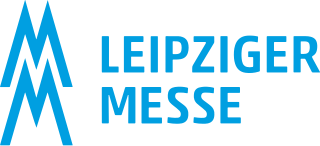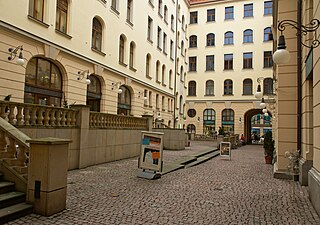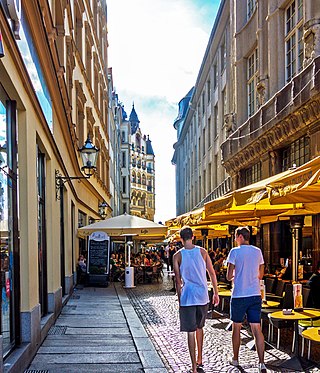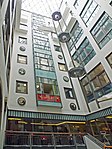
The Leipzig Trade Fair is a major trade fair, which traces its roots back for nearly a millennium. After the Second World War, Leipzig fell within the territory of East Germany, whereupon the Leipzig Trade Fair became one of the most important trade fairs of Comecon and was traditionally a meeting place for businessmen and politicians from both sides of the Iron Curtain. Since 1996, the fair has taken place on the Leipzig fairgrounds, located about 7 kilometres (4.3 mi) north of the city centre.

The Städtisches Kaufhaus in Leipzig, designed by the municipal architects Rayher, Korber and Müller in the style of Baroque Revival architecture, was constructed from 1894 to 1901.

The Brühl is a street in the centre of Leipzig, Germany, just within the former city wall. Until the 1930s, it was the international centre of fur trade.

The Augustusplatz is a square located at the east end of the city centre of Leipzig, borough Leipzig-Mitte. It is the city's largest square and one of the largest squares in Europe. It is also part of the city's inner-city ring-road and a central hub for its tram network.

Maximilian Speck von Sternburg was a wool merchant and art collector from Germany.

The Alte Handelsbörse or Alte Börse in Leipzig, Saxony, Germany, is the city's oldest assembly building of merchants, and also the oldest Baroque building. Built as the Börse in 1678, it is now used as an event venue and is known in English as the Old Stock Exchange.

The history of the architecture of Leipzig extends from the Middle Ages to the 21st century. Numerous typical buildings and valuable cultural monuments from different eras are still preserved or have been rebuilt. Leipzig, Germany, begins its architectural history with several buildings in the Romanesque style. An example of Gothic architecture in Leipzig is the late Gothic hall vault of the Thomaskirche (1482/1496). In the early modern period, the Old Town Hall was expanded in the Renaissance style. The city experienced the peak of urban design and artistic development from around 1870 to 1914 with historicism, Reformarchitektur and Art Nouveau. Numerous trade fair palaces, commercial buildings, representative buildings such as the Imperial Court Building and the new town hall and the arcade galleries known for the city were built. After the First World War, Leipzig became known for its neoclassicism. During the air raids on Leipzig in World War II, large parts of the city center, which was rich in historic buildings, were destroyed. This was followed in the post-war period by (socialist) neoclassicism and modernism.

Alte Messe Leipzig is the circa 50 hectares site in the southeastern part of Leipzig's district Mitte, where from 1920 until 1991 the technical exhibitions of the Leipzig Trade Fair took place, as well as the buildings that stand on it – but not the trade fair itself, which found a new home at a new site in the northern part of Leipzig. Since 1996 there has been no trade fair activity on the old site.

The Old Town Hall, which dominates the east side of the Markt square in Leipzig's district Mitte, is considered one of Germany's most important secular Renaissance buildings. At the rear is the Naschmarkt. The mayor and the municipal administration have been housed in the New Town Hall since 1905.

The Rundling, also called "Nibelungensiedlung", is a circular housing estate in the southern part of Leipzig in the Lößnig neighborhood.

The Wintergartenhochhaus is a 32-story high-rise building in Leipzig-Mitte, subdivision Ostvorstadt. The residential building was built from 1970 to 1972 as Wohnhochhaus Wintergartenstraße and is the third tallest high-rise in Leipzig after the City-Hochhaus and the Hotel The Westin. With a total height of 106.8 m (350 ft) and 95.5 m (313 ft) roof height, it was the tallest residential building in the East Germany and is now in the top hundred on the list of high-rise buildings in Germany. As a building of modernity and testimony of East German architectural history with rarity value, it is under cultural heritage protection.

The Markt is a square of about 1 ha in Leipzig's district of Mitte, Germany. It is considered the center of the city. The Old Town Hall stands on it, which demonstrates its particular historical importance. The square was named Platz des Friedens from 1950 to 1954. Its paving is a listed heritage monument.

Barthels Hof is a former trade court building complex in Leipzig in Germany, located in the borough Mitte. It is the last “through courtyard” that was preserved almost in its original condition. That means, the carts drove in, the goods were unloaded, and the carts drove out - without turning around. The horses were stabled in the suburbs. Later, from 1893 on, only samples of the goods were shown in the trade fairs and made to order. The Barthels Hof stretches from the market square to Kleine Fleischergasse and is now one of the city's most important sights. Today, it is used for a restaurant and some small shops.

The Mädler Arcade Gallery is the last completely preserved historic shopping arcade covered by an end-to-end glass roof in the city center of Leipzig. It is a facility of upmarket retail, restaurants, offices and cultural establishments.

The St. Nicholas Church Square is a square in the city center of Leipzig, Germany. The St. Nicholas Church stands on it. The church and square have particular significance for the Peaceful Revolution of 1989.

The 43 m (141 ft) tall Kroch high-rise in Leipzig was the first high-rise building in the city. It was built in 1927/28 as the headquarter of the Kroch Banking House, a private bank of the German-Jewish banker Hans Kroch (1887–1970), and is located on the west side of Augustusplatz. It is topped by a clock and two buff sentries modelled after the St Mark's Clocktower in Venice.

The Barfußgäßchen is a 160 m (524.9 ft) long residential street in the city center of Leipzig. It connects the market with the Dittrichring and is one of the city's party miles.

The Naschmarkt is a small square in the city center of Leipzig. It owes its name to a time when fruit was traded here, which was also considered a sweet treat at the time. Today it serves as an open-air restaurant in the warmer months of the year, while before Christmas it hosts part of the Christmas market.

The concept of the sample fair was invented in 1895 in Leipzig, Germany. At the Leipzig Trade Fair the traditional goods fair was replaced with sample shows. The sample fairs are the usual type of trade fair today, which is facing another paradigm shift due to the digital transformation, accelerated by the COVID-19 pandemic.






























